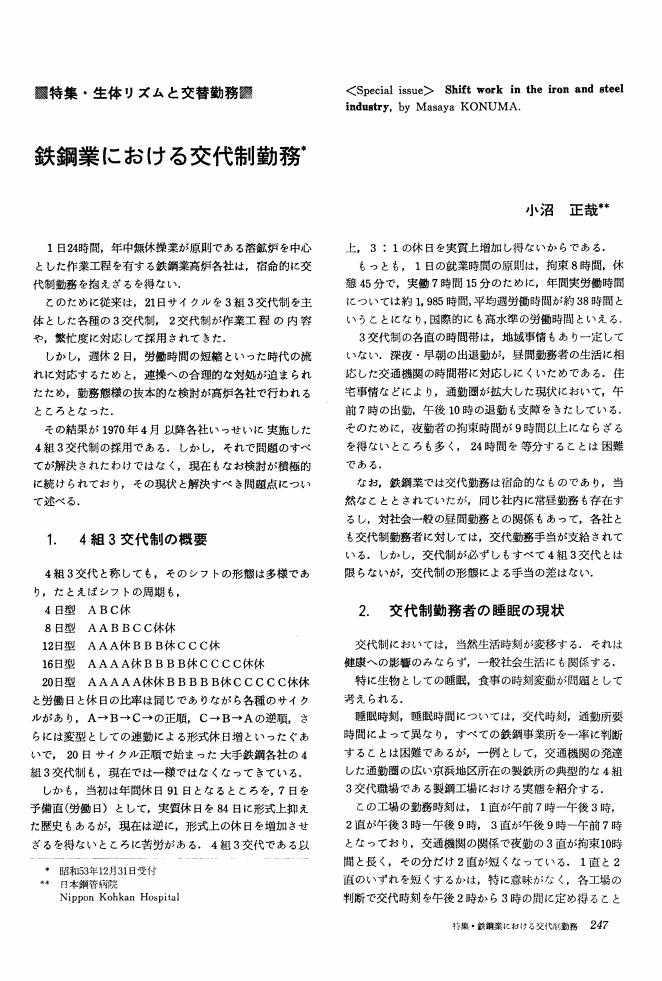2 0 0 0 OA 特定職域集団における死亡状況の観察
- 著者
- 中村 健一 近江 明 鈴木 誠一 小沼 正哉 栗原 忠雄 田寺 守 柴田 茂男
- 出版者
- 社団法人 日本産業衛生学会
- 雑誌
- 産業医学 (ISSN:00471879)
- 巻号頁・発行日
- vol.26, no.4, pp.303-314, 1984 (Released:2009-03-26)
- 参考文献数
- 21
- 被引用文献数
- 1 1 1
Mortality among employees of selected enterprises in which excellent health care programmes are carried on, was observed to evaluate employees' health levels and to establish objectives for future health care programmes. Also, these data were compared with those for all Japanese and for Japanese employees belonging to the corresponding occupational groups.Seventy-three enterprises which continuously participated in the mortality survey implemented by the Japan Research Organization of Industrial Health Care for the period between 1976 and 1980, were subjected to this study. The observed employees amounted to 3, 502, 580 person-years. Sex and age distributions of the employees were available for 47 enterprises and the observed employees totalled 2, 598, 672 person-years.The main results are as follows:1) Mortality rate (per 100, 000) is stable between 140 and 150 throughout the observed period and the average value is 145.0. The average mortality rate for males, aged 40 to 54, is 272.6.2) Malignant neoplasms were the main cause of death and account for 37-38%. In second place and below are heart diseases, cerebrovascular diseases, accidents, suicide and liver cirrhosis. Malignant neoplasms, especially of the stomach, lung and pancreas, show a trend to increase, and cerebrovascular diseases and liver cirrhosis show a trend to decrease. Among heart diseases, isch-emic heart disease accounts for about 40% and shows no marked fluctuation. Among cerebrovascular diseases, the relative frequency of subarachnoid hemorrhage is increasing.3) Comparing the mortality rates for males aged 40 to 54 by industry, “Iron, steel & nonferrous metal manufacturing” and “Electricity and gas supply” show significantly higher values, and “Finance & insurance” and “Communications” show significantly lower values than the total.4) The distribution of main causes of death for males, aged 40 to 54, was compared by major occupational groups using Proportional Mortality Ratio (PMR). A significantly high frequency of malignant neoplasms (especially of the stomach) is observed for “Professional & technical workers, managers and officials” and that of suicide for “ Craftmen, production process workers and labourers” and that of cerebrovascular diseases (especially cerebral hemorrhage) for “Protective service workers.”5) Standardized Mortality Ratio (SMR) for males, aged 20 to 54, from all causes of death, calculated on the basis of all Japanese males in 1978 is 0.57. SMR for this population from malignant neoplasms is 0.89. SMR for the same population from all causes of death, calculated on the basis of Japanese male employees in occupational groups corresponding to the studied population in 1975, is 0.75, and that from malignant neoplasms exceeds 1.00.Consistent with previous reports, mortality rates in this occupational population are significantly lower than those for the total population and the so-called “healthy workers effect” is demonstrated. Moreover, very low mortality rates from tuberculosis and cerebrovascular diseases suggest the effectiveness of disease control programmes which are implemented continuously and throughly in these enterprises. Efficient control programmes against malignant neoplasms remain to be established even in these well-cared populations.
1 0 0 0 OA 鉄鋼業における交代制勤務
- 著者
- 小沼 正哉
- 出版者
- Japan Ergonomics Society
- 雑誌
- 人間工学 (ISSN:05494974)
- 巻号頁・発行日
- vol.15, no.5, pp.247-250, 1979-10-15 (Released:2010-03-11)
- 著者
- 小沼 正哉
- 出版者
- 公益社団法人日本産業衛生学会
- 雑誌
- 産業医学 (ISSN:00471879)
- 巻号頁・発行日
- vol.9, no.9, 1967-09-20

